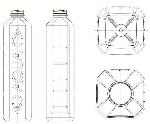BACKGROUND OF THE GENERAL COURT
The 5 January 2016 Volvis Holding SA filed an application for registration of an EU trade mark for a three-dimensional sign, for Classes 32, 35 and 39. The application was published in the European Union Trade Mark Bulletin on 1 March 2016, and on the 31 May 2016 Sun Stars and Sons Pte Ltd filed a notice of opposition on grounds of likelihood of confusion (Art.8.1b of the European Union Trade Mark Regulation).
- Contested trade mark three-dimensional sign:

- Earlier trade mark three-dimensional sign:

On 12 February 2018 the Opposition Division rejected the opposition in its entirety finding that there was no likelihood of confusion. The applicant appealed the decision, but the Fourth Board of Appeal dismissed the appeal the 6 August 2019. Against this decision another appeal was filed being the case up for decision for the General Court.
DECISION OF THE GENERAL COURT
The signs at stake are two three-dimensional marks consisting of a transparent bottle with an octagonal base and word elements within a vertical label placed on one side of the bottle. Regarding this fact, the General Court stresses that it is settled case-law that in this kind of situations the consumers will perceive the bottle as a simple container. A three-dimensional sign consisting of such a container is not distinctive unless it permits the average consumer to distinguish its products of those of the competitors, so, only a mark which departs significantly from the norms or customs of the sector will fulfil its essential function of indicating origin.
However it does not happen in the current case and the shape of the bottle must be regarded as having, at most, a weak inherent distinctive character. Regarding the words elements of the earlier mark, the distinctive character of the word “vodavoda” is weak as it has a descriptive character (it means water in Slovenian, Bulgarian, Czech, Polish and Slovak). Then, about the public which will not understand the meaning of the word, will perceive it as being fanciful, with a normal distinctive character. From the abovementioned, the General Court found that the earlier mark has a weak distinctive character overall.
In relation to the visual similarity, the General Court stated that since the shape of the bottle will be perceived as a mere variant of the packaging it is necessary to examine the word elements which are labelled in the bottles. And the Court found that the similarity between the bottles was largely offset by the words elements which are completely different, as the term “ac aqua ac” of the applied trade mark is not visually similar to the term “vodavoda” of the earlier trade mark. Thus, the Court stated that only a low degree of similarity existed between the marks.
Then, the signs were not found phonetically similar as the terms “ac aqua ac” and “vodavoda” sound completely different.
Regarding the conceptual comparison, the General Court found that the letters “a” and “c” in the mark applied for have no meaning and must be regarded as fanciful, so they will not be taken into account in the conceptual consideration. About the term “aqua”, that means “water” in Latin, it is assumed that the consumers from the EU will know about it. Then, about the term “voda” it will be understood as meaning water for the part of the relevant public which comes from Slovenia, Czech Republic, Bulgaria, Poland or Slovakia. The General Court concluded that for a significant part of the public there will be an average degree of conceptual similarity as both terms refer to the same concept of “water”.
In its final global assessment of the likelihood of confusion, the General Court stresses that it should be born in mind that in regards to water bottles consumers will focus mainly on the word and figurative elements on their labels, such as the logo or the trade mark’s name. Then, the Court found that for consumers who do not understand the terms “aqua” and “voda”, there will be no likelihood of confusion since the differences previously identified and in particular the lack of phonetic similarity as well as de low degree of visual similarity are enough to find that the overall impression given is different. And for those consumers who understand the terms “aqua” and “voda” also no likelihood of confusion is to be found since they will attribute even less importance to those terms and the impact of the conceptual similarity will be very low on the overall impression as the reference to “water” will not bring much attention.
Hence, due to the weak distinctive character of the earlier mark, the low degree of visual similarity, the lack of phonetic similarity and at the at most average conceptual similarity between the signs, the General Court stated that there was no likelihood of confusion in the present case.
Judgement of the General Court, case T-638/19 dated 1 May 2021


 Español
Español Deutsch
Deutsch